Pulmonary Manifestations in Patients With Hematologic Malignancies: In Pursuit of an Accurate Diagnosis
- PMID: 39949462
- PMCID: PMC11822728
- DOI: 10.7759/cureus.77418
Pulmonary Manifestations in Patients With Hematologic Malignancies: In Pursuit of an Accurate Diagnosis
Abstract
Pulmonary involvement is common in patients with hematologic malignancies (HMs) and varies depending on the underlying condition, including lymphoproliferative disorders, acute leukemia, myelodysplastic syndrome, and allogeneic stem cell transplantation. Pulmonary complications are a frequent cause of morbidity and mortality in these patients, often resulting from the immunosuppressive effects of the disease or its treatment. The clinical manifestations of these complications are nonspecific, and their differential diagnosis is broad, encompassing both infectious and noninfectious causes. A thorough clinical assessment requires consideration of factors such as the patient's history, baseline immune status, treatment regimens, time since the last chemotherapy, and environmental exposures. Radiographic imaging, particularly high-resolution CT, plays a critical role in evaluating these complications, helping clinicians identify distinct patterns of pulmonary involvement. Therefore, a personalized diagnostic approach is essential, and multidisciplinary management is crucial for optimal patient care.
Keywords: complications; diagnostic imaging; differential diagnosis; hematologic neoplasms; mortality; pulmonary disease.
Copyright © 2025, Alvarez-Payares et al.
Conflict of interest statement
Conflicts of interest: In compliance with the ICMJE uniform disclosure form, all authors declare the following: Payment/services info: All authors have declared that no financial support was received from any organization for the submitted work. Financial relationships: All authors have declared that they have no financial relationships at present or within the previous three years with any organizations that might have an interest in the submitted work. Other relationships: The authors of this article reside in two different countries, because Dr. Edwin Uriel Suárez completed his studies in Internal Medicine at the University of Antioquia, Medellín, but subsequently moved to Spain to pursue his studies in Hematology. Nevertheless, the authors have maintained contact for the preparation of this article.
Figures















Similar articles
-
Acute pulmonary complications in patients with hematologic malignancies.Radiographics. 2014 Oct;34(6):1755-68. doi: 10.1148/rg.346130107. Radiographics. 2014. PMID: 25310429 Review.
-
[Lung involvement in hematologic systemic diseases].Internist (Berl). 2018 Sep;59(9):886-897. doi: 10.1007/s00108-018-0471-9. Internist (Berl). 2018. PMID: 30046891 Review. German.
-
Epstein-Barr virus-positive lymphoproliferative disorder manifesting as pulmonary disease in a patient with acute myeloid leukemia: a case report.J Med Case Rep. 2021 Mar 28;15(1):170. doi: 10.1186/s13256-021-02744-2. J Med Case Rep. 2021. PMID: 33773605 Free PMC article.
-
Extracorporeal photophoresis: an evidence-based analysis.Ont Health Technol Assess Ser. 2006;6(6):1-82. Epub 2006 Mar 1. Ont Health Technol Assess Ser. 2006. PMID: 23074497 Free PMC article.
-
Alloreactivity as therapeutic principle in the treatment of hematologic malignancies. Studies of clinical and immunologic aspects of allogeneic hematopoietic cell transplantation with nonmyeloablative conditioning.Dan Med Bull. 2007 May;54(2):112-39. Dan Med Bull. 2007. PMID: 17521527 Review.
Cited by
-
Pulmonary diffuse large B-cell lymphoma with concurrent organizing pneumonia: a case report.Front Med (Lausanne). 2025 Aug 6;12:1599268. doi: 10.3389/fmed.2025.1599268. eCollection 2025. Front Med (Lausanne). 2025. PMID: 40842531 Free PMC article.
References
-
- Pulmonary disease in non-pulmonary malignancy. Cheng GS, Possick JD. Clin Chest Med. 2017;38:0. - PubMed
-
- Cancer incidence, mortality, years of life lost, years lived with disability, and disability-adjusted life years for 29 cancer groups from 2010 to 2019: a systematic analysis for the Global Burden of Disease Study 2019. Kocarnik JM, Compton K, Dean FE, et al. JAMA Oncol. 2022;8:420–444. - PMC - PubMed
-
- Acute pulmonary complications in patients with hematologic malignancies. Choi MH, Jung JI, Chung WD, et al. Radiographics. 2014;34:1755–1768. - PubMed
Publication types
LinkOut - more resources
Full Text Sources
